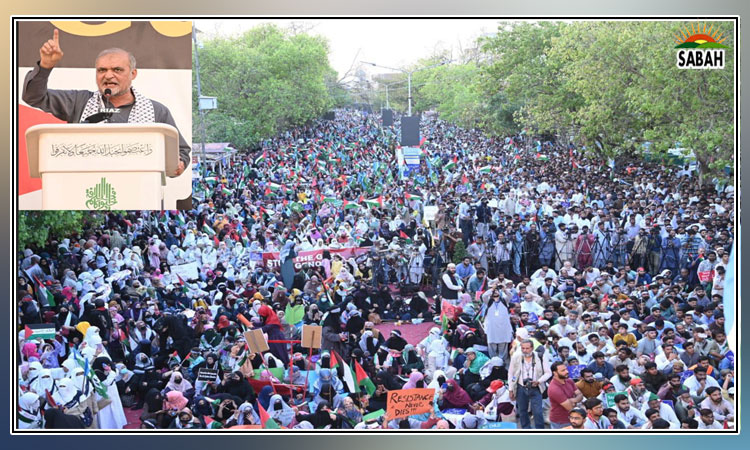Monsoon anxiety…Naseer Memon
THE onset of the monsoons has triggered a wave of anxiety as early rains have resulted in a number of causalities. The National Disaster Management Authority has already reported 133 deaths countrywide. Rain spells that began in the last week of June continue to lash different cities. Strong showers have inundated roads and underpasses in Lahore and triggered alarm in Rawalpindi as the Leh Nullah crossed the flood threshold.
Although Sindh and Balochistan, the worst hit in last years epic floods, have suffered few fatalities and less damage so far this year, there is anxiety in both provinces as last year, while both received above-normal rains in July, the worst came in the latter half of August when cloudbursts smashed rain records. Sindh received 700 per cent more than the average rainfall in August. It caused urban flooding in several towns and Khairpur Nathan Shah was completely inundated. The situation was aggravated by the run-off from Balochistan that entered via western Sindh, submerging hundreds of kilometres of land.
The prognosis of an innocuous monsoon by the South Asian Climate Outlook Forum and the Pakistan Meteorological Department indicate low rainfall and higher temperatures due to the El Nio effect. Nevertheless, higher temperatures mean greater snow and glacial melt in the upper reaches of the Indus that can generate more flows that would ultimately reach Sindh. The upper areas of the country are gripped by a wet cycle. Resultantly, canals in Punjab and Sindh are receiving excessive water from the Indus, with 25,000-30,000 cusecs flowing below Kotri Barrage. The katcha area is saturated. Almost 90 per cent of the water released from one barrage is reaching the downstream barrage in Sindh. Flows from India will also reach Sindh before August and the Indus will start swelling.
Weather pundits have predicted medium to high floods of 350,000 to 500,000 cusecs in Sindh during this monsoon enough to submerge the floodplain locally called the katcha area. If the river embankments are maintained properly, this amount does not pose a serious flood threat. Rather, it brings fertile silt and recharges groundwater in adjoining areas, a boon for the riverine ecosystem. In the years before the Tarbela Dam was built, low floods of 300,000 cusecs were an annual feature and medium floods of 500,000 cusecs also occurred. This flood pattern maintained a healthy riverine ecosystem and a prosperous rural economy, helping to sustain dense riverine forests and an economy of natural resources including seasonal organic crops, forest products, dairy products and fisheries.
Storm drains and a functional pumping system are an urgent need.
In the post-Tarbela decades, this pattern went topsy-turvy. Water flows to Sindh declined over the years. According to available data, Kotri Barrage received 80 MAF water during the pre-Tarbela years (1955-65). The quantum declined in the post-Tarbela years to 46 MAF during 1966-76 and to 35 MAF during 1977-92. Floods became more erratic. The diminishing frequency and intensity of floods exposed large tracts of land in the katcha area for agriculture and human settlement. As forests were chopped down, the land was further denuded for more cropping. This also changed the sociology of the katcha area which has now properly built villages with roads and schools. Influential characters own vast tracts of farmland and some are powerful enough to erect dykes to protect their crops from floodwater. These unauthorised structures have altered the river regime due to which silt deposition creates sand dunes, and diverted flows can exert stress on embankments during high floods.
Urban flooding is a relatively new phenomenon. Over recent decades, Sindh has witnessed a high pace of urbanisation. District headquarters are now bursting at the seams and an inadequate, dilapidated drainage infrastructure is unable to handle even the normal sanitation load. Streets in major towns often find themselves under pools of stinky sewage, and heavy rainfall becomes a nightmare. Last year, pumping stations failed to perform, and towns remained inundated for days. Storm drains and a functional pumping system are an urgent need to avert urban flooding.
Based on the weather forecast, the monsoon contingency plan of the Sindh Provincial Disaster Management Authority estimates a population of 93,000 to be affected in case of medium floods and 408,000 people in a high-flood situation. If this assessment is accurate, it will give Sindh, that has not yet fully recovered from the devastation of 2022 floods, some breathing space and allow the government to complete the rehabilitation of last years flood victims by reconstructing more than two million houses, repairing intra-district roads and rebuilding 20,000 schools and the vital irrigation infrastructure.
Courtesy Dawn












